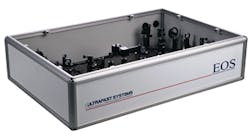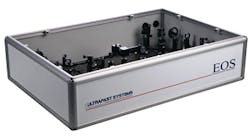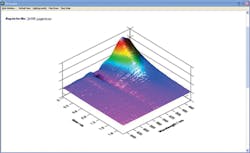EOS is a broadband optical absorption spectrometer manufactured by Ultrafast Systems LLC (Sarasota, FL) for characterizing transient chemical species with lifetimes in the sub-nanosecond to multi-millisecond time window. It operates on the pump-probe method, where the pump is a sub-nanosecond or shorter laser pulse and the probe is a white light pulse of sub-nanosecond duration from a supercontinuum crystal fiber source, manufactured by Leukos (Limoges, France). EOS thus represents a fruitful cooperation between a pair of small high-tech companies operating in diverse trans-Atlantic enterprises.
EOS is a cousin of Helios, Ultrafast Systems' broadband optical spectrometer with an operational time window of ~200 fs to ~8 ns. The long-time edge of the window is determined by the length of time delay that can be introduced in a pair of contemporaneous light pulses using reflectors on a mechanical delay line. Longer delays than 8 ns require delay lines that would be unwieldy, expensive, and could provide only a limited extension of the time window. So to extend the observational time window, Ultrafast Systems had to come up with a different way of delaying the arrival of the probe pulse at the photolyzed sample. Their solution was to revert to the original pump-probe scheme introduced by Norrish and Porter in 1949 (for which they were awarded The Nobel Prize in Chemistry in 1967) in which an intense flash of light was used to generate photolytic products in the sample under test, and a weaker flash from a second flash lamp was employed for spectral analysis. The probe flash was triggered electronically at a variable delay after the primary flash. These flashes were generated in gas-filled tubes by the discharge of capacitors, which limited the time resolution to the millisecond regime.
Improvements in time resolution over the years were obtained by using Q-switched lasers for excitation and continuous photo-electric recording. This methodology enabled researchers to resolve transient lifetimes from a few tens of nanoseconds up to the multi-millisecond regime, thereby providing a wealth of information about the temporal behavior of a multitude of photo-generated entities. Photoelectric recording could not be made more rapid because of the inherent rise time of electronic circuitry, which, coupled to the intrinsic pulse duration of Q-switched lasers, gave rise to the unavailabity of information during the first tens of nanoseconds post-excitation. The advent of ultrafast lasers, coupled to pump-probe spectrometry, overcame this short-time difficulty, and the Helios absorption spectrometer, coupled to mode-locked amplified Ti:sapphire lasers, can be found in close to 80 research facilities across the globe. Still, there remained the problem of the time-window limitation and researchers found themselves in the position of having excellent definition of the subpicosecond to few-nanosecond time window, but no information of the temporal behavior of longer-lived species. Such information could only be gained by going to the expense of purchasing a complete Q-switched laser plus a supra-nanosecond spectrometer system. Even if they did this, the time windows were difficult to fully superimpose.
In the light of this situation, some 10 years ago engineers at Ultrafast Systems began experimenting with ways of extending the Helios time window. It quickly became apparent that the only feasible way would be to adopt the Norrish-Porter pump-probe concept of using two independent pulsed light sources; the ultrafast laser source for pumping the sample as in Helios, and a to-be-discovered pulsed white light source for probing. It was fortunate that at this time, Leukos was investigating so-called "supercontinuum" sources based on the development and use of a new generation of optical fibers. Such waveguides, pumped by a subnanosecond pulse from an Nd:YAG laser, enabled extreme confinement of the electromagnetic field and a high frequency conversion efficiency by means of nonlinear optical effects. The interaction of the light delivered by a high-power pump laser with the material constituting the fiber permits the generation of a multitude of wavelengths (a supercontinuum from the ultraviolet to the infrared). In its current format, the Leukos source coupled into EOS has a spectral bandwidth from 350 to 1800 nm at a 2 kHz repetition rate with a typical pulse width of ~700 ps. This pulse width determines the short time edge of the EOS time window, falling well within the 8 ns time window of Helios. Since the supercontinuum source is independently triggered from the pump laser, the time window of EOS extends up to the limit imposed by the repetition rate of the probe source pumping laser (several hundred milliseconds). Thus the EOS spectrometer (see Fig. 1), coupled to a femtosecond Ti:sapphire laser (or almost any other short pulse laser) for photo-excitation, provides researchers with a tool for measuring the nature and reactivity of photo-generated transient states with lifetimes from the very early nanoseconds up to multi-milliseconds.
Moreover, the Helios-EOS combination, built in the same housing and sharing many optical and mechanical parts, conveys the ability to make measurements in a time window stretching seamlessly from a few hundred femtoseconds to sub-second. In both Helios and EOS spectrometers, after interrogating the pumped sample, the probe beam is directed to the input slit of a spectrograph/array detector combination such that, for every delay time setting, a dispersed optical spectrum is registered on the array detector. In this way, a dynamic surface of absorbance-wavelength-time (A λ-λ-t) is collected (see Fig. 2).
Trigger jitter compensation
The two flash lamps in the Norrish-Porter experiment were fired independently, and this worked fine for their time scales of multi-milliseconds, where timing uncertainties such as jitter were insignificant. However, on the sub-nanosecond time scale of EOS, timing jitter is not negligible; the Leukos probe source is specified with an inherent firing jitter <20 ns, which, as it stands, would make EOS impractical on timescales below ~50 ns. EOS surmounts this problem in a similar way to the operation of a time-correlated, single-photon-counting spectrometer. A fraction of the pump laser beam is used to provide the "start" marker of a time-to-height converter, and a fraction of the next probe pulse is used as a "stop" marker. The amplitude of the resulting output pulse is proportional to the time between "start" and "stop" markers and the signal intensity from the probe event in the sample is recorded in the bin that represents the "start" to "stop" time interval. This sequence is repeated for a series of pump-probe delay lsettings and as a result the bin contents record a representation of the experimental time profile. In this way, the jitter is compensated for.
—Michael A. J. Rodgers and Alexey V. Gusev; [email protected]
We welcome your comments. Send letters to Lee Dubay, at [email protected]. Letters may be edited for length.


